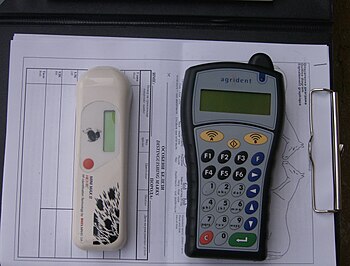Every pet owner wants to keep his or her beloved cat or dog as safe as possible. You do everything you can do make sure your pet is well cared for and healthy. If you have an indoor pet, you may not think that keeping identification tags is important, but it is. What if your fuzzy feline accidentally slips out of the door at night and you search to no avail? What do you do, especially if your dog or cat has no identification? Placing a collar with an identification tag is important, but collars sometimes become lost. When you consider the fact that many animal shelters only keep dogs and cats for seven days, you want to make sure that your pet is properly identified. That is where the microchip comes in handy. The microchip is the newest way to identify lost pets and helps ensure that your lost pooch or feline finds his or her way back home.
 |
| Microchip Scanner (Photo credit: Wikipedia) |
The technology of the microchip has become so popular that most animal clinics and animal shelters have the ability to scan a cat or dog for microchip identification. If you opt for the microchip, you should know that it is a painless procedure for your pet. Your vet will insert a tiny microchip about the size of a grain of rice directly under your pet’s skin using a hypodermic needle. The microchip is usually placed behind the neck. The microchip contains special digital number that has been entered on a national microchip database. That information will give the person your contact information. When you pet is lost, a veterinarian or animal shelter can use a special scanner to retrieve the microchip information. It is that easy.
Pet owners love the idea of the microchip because it is permanent. You cannot remove the microchip and unlike a collar or tags, it cannot be lost or destroyed. This is one of the best features of pet microchip, especially for cats. If you place a collar on a cat, more than likely it will be a breakaway collar. If your cat climbs a tree, or is caught on something, the collar breaks off. If your cat does not have a microchip, it will be very difficult to identify your cat if it is found.
There are a few important things to remember about pet microchips. First, if your pet gets lost, you should never just sit back and wait for a call, even if your pet has a microchip. Not all veterinarians and shelters are equipped with this technology. You need to take the time to call around and place “lost pet” flyers around your neighborhood. In addition, you need to make sure you take the time to update your contact information should you move. It does little to no good to have your pet implanted with the microchip if the information on the national database is incorrect. Your veterinarian can give you information on how to update this information.
It is important to get your pet implanted with the microchip at a young age. Puppies can have the microchip at age six weeks. Even small breeds of dogs can handle this procedure. Kittens can also undergo this procedure at six weeks. The insertion of the microchip is not painful and feels like a regular vaccination shot. You can have your pet implanted with the microchip at your veterinarian office and can expect to pay between $30 and $50 for this service.
